I have been writing about the ceramic tile sector for more than 40 years now and I can say with some certainty that 2022 was a year unlike any other.
In common with other mature industrial sectors, the past four decades have seen the global ceramic tile sector impacted by geopolitical forces and traumatic world events, such as the 2008 global financial crisis; 9-11; and the Gulf War. But this year several powerful negative forces have been at play simultaneously – and they have impacted on everyone in the global ceramic tile community.
As well as the Coronavirus pandemic, the UK has been additionally challenged by Brexit and the soaring energy prices resulting from the war in Ukraine.
These three challenges have had a particularly acute impact on the ceramic tile market. Take Brexit, for instance. The UK only has one remaining volume tile manufacturer, Johnson Tiles, so the vast bulk of this £950million+ market relies on imported tiles. Spain and Italy have been traditionally two of the major supplier nations and they now face expensive delays and painful paperwork to keep contracts supplied and warehouses stocked.
Looking forward, emerging producer nations, such as Brazil, China and India could offer alternative sources, but only when the UK signs a raft of yet-to-emerge international trade deals. And importing tiles from far away has many downsides, particularly given the escalating cost of marine fuel. With a container ship consuming 60,000+ gallons of marine fuel per day, this is no small consideration, and has led to a huge rise in freight transport costs.
In July 2020 the average price of shipping a 40ft container from China to the UK was around £1,500. Today that figure is nearer £11,000, a staggering 630% increase. And the problem does not end there, because higher diesel prices mean the cost of getting tiles from port to warehouse to customer have all risen significantly.
The war in Ukraine had a particular impact on the tile sector. Just as bakers suddenly woke up to the fact that Ukraine was a major source of wheat, the tile industry discovered that Ukraine was a key exporter of clay, which is the core ingredient of any tile.
The development of porcelain tiles means that the clay extracted near the main European ceramic hubs – Castellon in Spain and Sassuolo in Italy – is no longer fit for purpose. Prior to the outbreak of hostilities, Ukrainian clays accounted for 25% of all the raw materials used by the Italian ceramic industry. While alternative supplies are available – from the UK, Turkey, and across Eastern Europe – it is not easy to suddenly source and ship thousands of tons of clay to your factory.
And when these alternative sources of clay did arrive, manufacturers found that subtle differences in chemical composition meant tiles made from them displayed subtle colour differences when fired. To maintain design consistency, manufacturers had to reformulate thousands of products, with particular emphasis on new engobe compositions to decorate and texture the tiles.
After these technical difficulties were overcome, the spiralling gas prices – still the primary fuel in tile production – and other inflationary pressures compounded the need for price hikes.
At the start of the year the situation was so acute that Confindustria Ceramica, the Italian tile manufacturers’ association, took the unprecedented step of sending out press bulletins to explain the situation in the hope of calming the market’s fears.
In mid-March, when gas prices reached a record level of €3.50 per cubic metre, 30 factories in Italy (out of around 220) stopped production and furlough agreements were put in place for 4,000 workers. There were also significant shut downs in Spain. And the decision to shut down is never taken lightly because of the potential damage caused to kilns when they cool down.
Looking forward, Spanish and Italian companies are seeking to diversify their gas and material supply chains, both by extending the number of European suppliers they buy from and by seeking new sources from outside Europe.
There are hopes that hydrogen-fuelled kilns will offer a more sustainable manufacturing path eventually, although that will only become viable when the price of hydrogen falls, as it inevitably will with economies of scale and innovations as production increases.
You might think these pressures on the market would have caused a slow down in mergers, acquisitions, and capital investment, but all three have continued apace. And there is no doubt that we will see more companies pursuing a policy of growth through acquisition.
The largest player in the world ceramic tile market is the US-based Mohawk Group. It has built a powerful portfolio of tile brands over the past decade, including American Olean, Daltile, Decortiles, Eliane, Kerama, Marazzi, Emilceramica, and Ragno. In June 2022 it significantly expanded its tile presence with the acquisition of Vitromex, the leading tile manufacturer in Mexico. Next in line looks like being Elizabeth, one of the largest tile manufacturers in Brazil. The purchase is expected to be completed in 2023.
In the UK, Victoria PLC has been steadily amassing a powerful portfolio of tile brands, with Ascot, Casabella Ceramiche, Casainfinita, Ceramiche Capri, Ceramica Colli de Sassuolo, Dom Ceramiche, Keradom, and Vallelunga & Co in Italy, and Ibero Porcelanico, Keraben, Metropol, and Saloni in Spain. In 2022, Victoria made a significant move into the North American market with the acquisition of Cali, the San Diego-based flooring distributor with various B2C and B2B platforms.
In Italy, Graziano Verdi continues to drive the growth of the Italcer Group. Its high-end tile brands include La Fabbrica Ceramiche, Elios Ceramica, Ceramica Rondine, Cedir, and Equipe Cerámicas. The latest brand to be added to the portfolio is Ceramica Fondovalle, a €50million Sassuolo-based manufacturer with particular expertise in large slabs. With this acquisition, Italcer is anticipated to reach a consolidated turnover of €370million in 2022, with an EBITA of €80million.
Consolidation has also been taking place among distributors. In the UK, Topps Tiles has acquired 60% of the issued share capital of Pro Tiler Ltd, an online supplier of tiling products to the trade. Topps has an option to purchase the remaining 40% that is exercisable from March 2024.
The commercial arm of Topps Tiles – Parkside and Strata Tiles – aligned to become sister brands. These two tile specification companies are looking to become market leaders in the UK’s commercial tile market by 2025.
In tools, Husqvarna Group's Construction Division, a world leader in diamond tools for the stone industry, has acquired Heger, another specialist in professional diamond tools.
The attractiveness of the tile sector was underlined when CTD Tiles, the UK’s largest tile distributor, announced its acquisition by private equity group Aurelius Investments. Previously under the ownership of Saint-Gobain, the sale comes at a time of growth for the company and included all brands in The CTD Group.
Aurelius will work with CTD’s experienced management team to leverage its leading B2B market position by expanding its e-commerce offering and to continue the company’s operational development. Aurelius also sees opportunities for opening new trade counters and additional branches in key locations across the UK.
2022 also saw the launch of a new brand in the UK tile sector: the Gölz group, based in Germany. With 75 years’ experience in high quality machinery and diamond accessories, Gölz has had a presence in the UK since 1987, providing expert technical and sales support for a range of professional machinery and diamond tools for the construction industry. Now, with the addition of the new 110V table saws, Gölz can also supply tile and stone customers with saws that can be used onsite as well as in the factory.
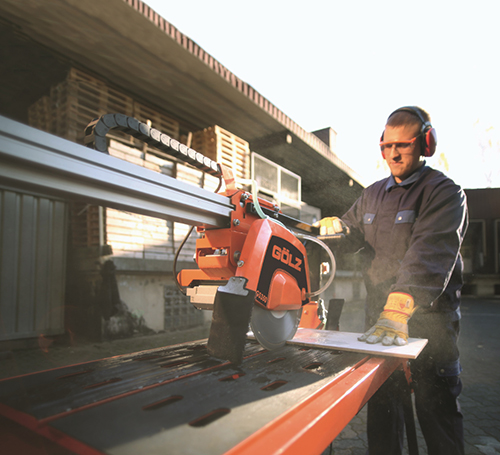
There were two significant accolades for the UK’s ceramic tile sector during the year. In January, Brian Newell, Chair and Founder of the TTA Technical Committee, was made an MBE in the New Year’s Honours. Brian, the CEO and Founder of Shackerley Holdings, was a founding member of The Tile Association and in his long career has helped to deliver the TTA’s key aspirations of improving standards and driving quality through the UK tiling sector.
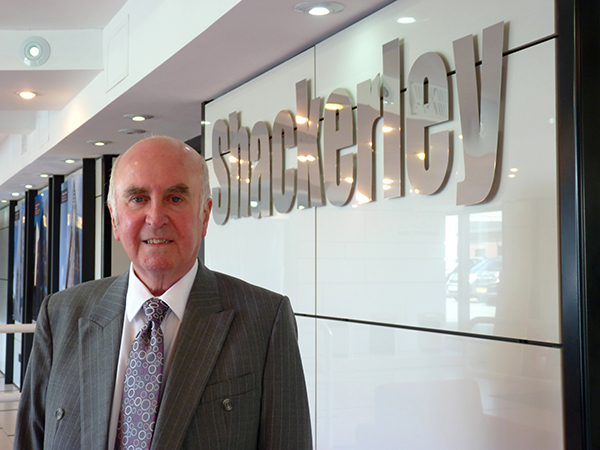
He joined the BSI Committee B539 in the 1980s and went on to develop and draft the first British Wall & Floor Tile Installation Standards (BS 5385 Parts 1-5) and the first tiling Workmanship on Site Standards (BS 8000).
In another impressive accolade, Instarmac Group received the Queen’s Award for Enterprise for International Trade 2022.
Environmental enthusiasm
2022 will also hopefully be remembered as the year when the ceramic tile sector really put its green foot forward. For some time now companies like Kerakoll have driven the environmental agenda, while others seemed happy to talk the talk, but not walk the walk. This year, particularly at Cersaie, a major European tile exhibition, it felt as though green wash had been replaced by clear sustainability initiatives backed up by research and investment. Giovanni Savorani, Chairman of Confindustria Ceramica, stated: “The Italian ceramic industry’s commitment to sustainability was the common thread running through the entire show.”
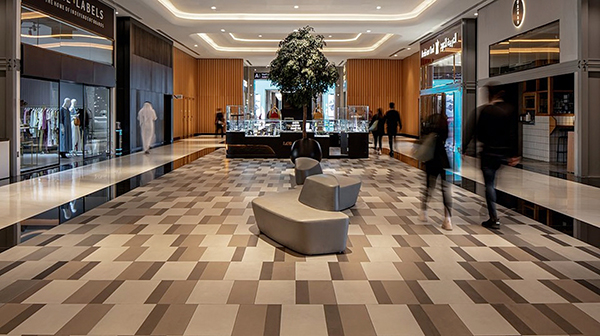
Green initiatives seen across the ceramic sector included Grespania installing photovoltaic panels on the roof of its plant in Moncófar, Castellón. This 907kWp array is capable of generating 1.3GWh of clean energy a year – or 30% of the total energy requirement for its factory.
Instarmac Group has invested more than £400,000 on state-of-the-art solar panels at its factory in Tamworth, Staffordshire. Perfect Sense Energy installed 1,656 solar panels across a 3,771m2. The 768kW solar panels will generate 680,000kW of clean green energy for Instarmac.
Mosa has achieved Cradle to Cradle Certified Gold for its ceramic floor and wall tiles. With 99% of its products already certified at the Silver level, it wanted to go all the way by moving up to Gold according to version 3.1 of the Cradle to Cradle Certified Product Standard.
Taking another slant on sustainability, on the natural stone side of the industry Stone Federation announced its Responsible Sourcing Pledge. This is an opportunity for Stone Federation members, architects, designers, engineers, and major contractors to demonstrate commitment to the sustainable sourcing of natural stone. It follows the 2012 publication of the Stone Federation Sustainability Statement and, four years later, The Ethical Stone Register. More than 20 of the UK stone industry’s leading names immediately signed the Responsible Sourcing Pledge.
On a smaller scale, Parkside and Strata’s Clerkenwell Sustainability & Design Studio was home to a programme of activities during Clerkenwell Design Week, including The Next Generation, showcasing student sustainability concepts. Parkside’s James Journet observed: “Clerkenwell Design Week is a great chance to really get stuck into conversations and explore how we can collaborate as an industry to become more sustainable in our actions.”
Exhibition upheaval
There was no Cevisama this year. Spain’s international ceramics and bathroom equipment trade fair in Valencia was initially moved from February to June, due to the impact of the Coronavirus pandemic. As the crisis rolled on, and faced with growing manufacturer scepticism, the organisers had little chance but to pull the plug. The show is scheduled to be back in its usual February slot in 2023, but with exhibitor numbers still below the event’s peak, many in the industry are expressing doubts about its long term future.
Cersaie in Italy, meanwhile, marked a welcome return to something like business as usual, as more than 90,000 visitors flocked to Bologna in September, roughly twice the number that braved last year’s Covid-constrained event.
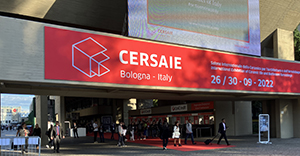
It was great to see visitors from Australia and New Zealand back assessing trends and making deals, alongside good numbers from the USA, Canada, and Europe. Unsurprisingly, there were few Chinese visitors among the 44,215 international attendees, but that was only to be expected given the pandemic restrictions that were still in place there.
Revestir, Latin America’s foremost surfaces show, celebrated it’s 20th anniversary in March, covering all seven pavilions of the Transamerica Expo Center in Sao Paulo, Brazil. It was the last time the event will be held at this venue, as it moves to São Paulo Expo at Rodovia dos Imigrantes in 2023.
The 2022 event was unique because, in response to the global Coronavirus pandemic, it had a hybrid format, part digital and part face-to-face. The digital version allowed visitors to save admired products and brands and check out launches from the in-person event. The platform also hosted FIAC (International Forum of Architecture, Design & Construction), with presentations from the likes of Dutch designer Maarten Baas and American architect Charles Renfro.
Coverings, the US-based exhibition, goes from strength to strength. In 2021 it was held in Las Vegas, but returns to its spiritual home, Orlando, in 2023.
As the American market has grown, and Kentucky expands as a tile manufacturing hub, this show looks set to join Cersaie as a key date in the tile calendar. The April date is ideally spaced five months from the Bologna showcase, allowing the Spring and Autumn collection concept to return. Orlando is blessed with a plentiful supply of hotels, but the strong Dollar and the rising cost of air fares may yet deter a greater number of overseas visitors from attending the next event.
It is not my intention to discuss tile design trends here, but it is worth mentioning three sub-sectors of the market that all moved ahead in 2022: façades; worktops; exterior paving.
The first two sectors exploit porcelain’s technical qualities, as well as its aesthetic properties. Sales of mechanically-fixed ventilated façades have been growing in the UK for many years now, driven by pioneers like Shackerley Holdings and Domus Façades. Now, with big brands like Apavisa, Marazzi, Caesar, Porcelanosa, and Grespania banging the drum, it is surely time for tiled façades to take off. In the wake of Grenfell, fire-safe cladding solutions are at an all-time premium, and porcelain has a strong specification story to tell.
The rise of porcelain worktops has been driven by the widespread adoption of continuous pressing technology and digital decoration. These make it possible to create incredibly detailed 1800mm by 3600mm porcelain panels or varying thickness. With the beginning of through-body decoration and elegant book-matched designs, the market has exploded. But while there are now many factories in Italy, Spain, and beyond capable of producing these slabs, the market is being held back by a lack of trained and skilled fabricators and installers.
To achieve the best results requires significant investment in people, equipment, substrates, and construction chemicals. It also relies on specialist distribution and advanced material handling. Little wonder then that both porcelain façades and worktops will be key areas of interest at Hard Surfaces in June next year when it returns to ExCeL in London to co-locate with the Natural Stone Show.

Both façades and worktops can greatly benefit from enhanced communication and technical training, and this will be clearly demonstrated both on the exhibition floor and in the seminar programme at this important ExCel-based event.
The stand-out tile sector in 2022, however, was 20mm thick external porcelain.
It took some time for manufacturers and distributors to wake up to the full potential of the external tile market in the UK but now they have it is developing fast.
As well as the traditional manufacturer-to-distributor-to-retailer route to market, 20mm outdoor pavers can now be found via online specialists and in garden centres, builders merchants, and many other retail locations. They are being installed by landscape contractors, local authorities, and property maintenance companies as well as by traditional tilers and competent DIYers.
The ability to dry lay, adhesive fix, or pedestal mount these 20mm tiles makes them unusually versatile. They are particularly popular with in the hospitality sector because of the vogue for al fresco dining and drinking, but they are equally suitable for use outside commercial or retail premises, on patios and balconies, for footpaths and driveways, or creating seamless inside-out architecture almost anywhere.
Outdoor paving options cover everything from small format bricks and mix and match sandstone paving through to large format slabs and porcelain tiles are a good solution for larger spaces, with sizes varying from supersized 1000mm by 1000mm modules, through XXL 600mm by 1200mm rectangles, to 200mm by 1200mm and 300mm by 1200mm planks. Uniform in thickness, they can be combined to create a personalised look or used to visually separate different outdoor zones.
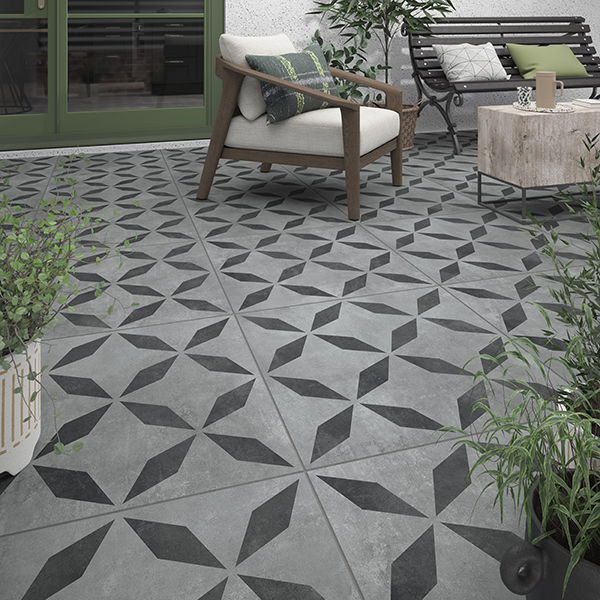
Most stockists include a range of muted tones such as beige, light grey and charcoal, alongside bolder options such as light woodgrains and encaustic-inspired cement patterns. But the market in 2022 has also seen Victorian-inspired patterns with strong repeating lines and fleur-de-lys motifs and geometric designs with symmetrical, abstract patterns. There is a wide choice of natural effects available including stone-, marble-, concrete-, wood- and slate-effects.
And the commercial benefits are significant. One long-established tile distributor told me that 2022 was the year when sales of 20mm exterior tiles overtook traditional wall and floor tiles in both volume and value. And one of the leading tile agents confirmed that exterior grade tiles now account for more than half of his sales.
The UK tile market is in surprisingly rude health as we head for 2023. Apart from the three sectors outlined above, we have the potential of 3mm mesh-backed sheets, such as Laminam, to factor in. These can be used for everything from civil engineering applications (such as tunnel lining) to furniture facings or bespoke murals.
And we should be aware of a significant trend at Cersaie – application diversity. This is less about product design than marketing direction, with tiles are being promoted for bedrooms, not only walls and floors but also bedheads and even ceramic bed frames, tiled hallways and corridors, fireplaces, and outdoor kitchens. External tiling had also moved from 2D to 3D forms – planters, water features, and raised seating.
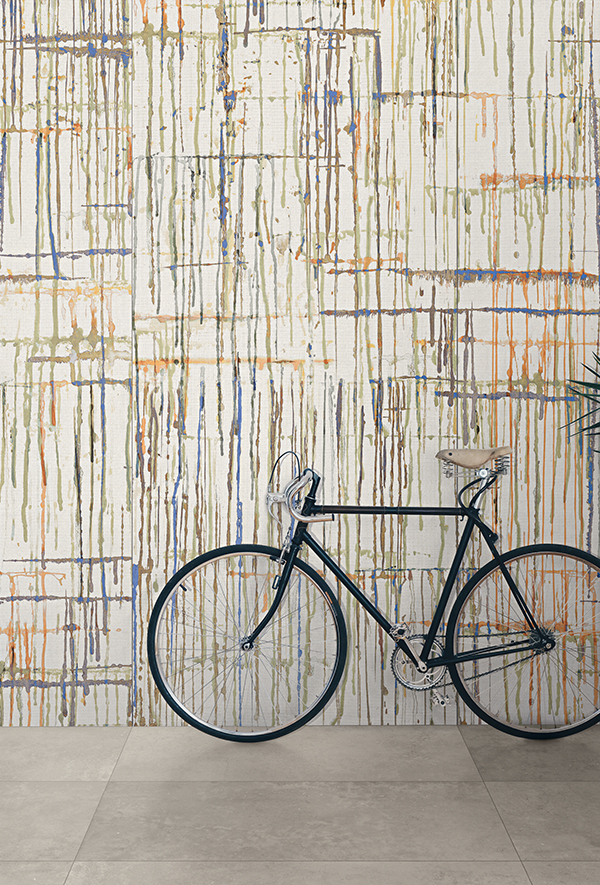
These new application areas should inspire tile retailers and distributors and the architect and design community.
Despite the challenging global backdrop, 2023 holds real promise for the UK’s tiling sector.

